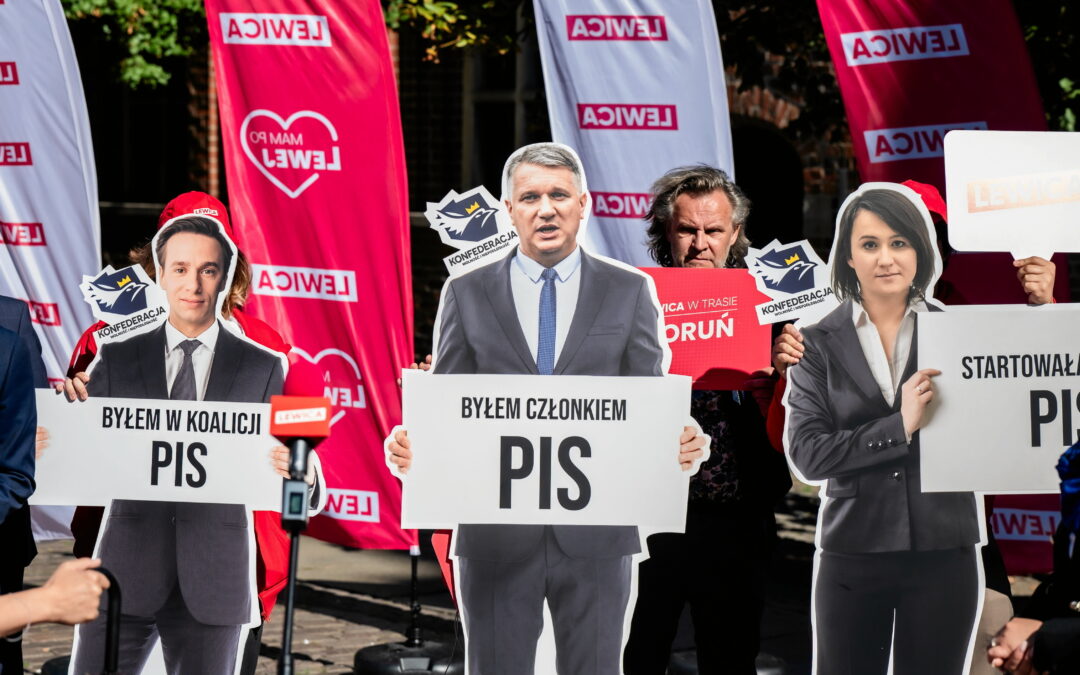By Roman Broszkowski
Less than a month before Poland’s elections, 27-year-old Warsaw resident Wojtek has decided how he will vote: he is going to spoil his ballot.
“For me, the quality of politics [in Poland] is so low that it’s just horrible to even participate,” he says. “In every other country, [if you’re a politician and] you’re doing something wrong…somebody would lose their position already. But here, there’s plenty of things that can go wrong, and nobody feels the pressure to feel bad for it. I just hate it.”
Wojtek’s frustrations are not uncommon among Poland’s youngest voters. After 18 years of alternating rule between the national-conservative Law and Justice (PiS) party and the centrist Civic Platform (PO), many are frustrated.
Young people in Poland and Spain are the least optimistic about their own futures among all EU countries https://t.co/kYwClFXUJ8
— Notes from Poland 🇵🇱 (@notesfrompoland) January 6, 2022
Those who, unlike Wojtek, have not given up on politics altogether are considering alternatives.
“The youngest cohorts of voters, they have basically not known anybody else in power,” says Tom Junes, an assistant professor at the Institute of Political Studies of the Polish Academy of Sciences. “It’s not that unexpected that young people would look at other alternatives.”
Two groups in particular hope to benefit from this disillusionment: the far-right Confederation (Konfederacja) and The Left (Lewica). In the 2019 election, both had their largest success among voters aged 18-29.
This trend has continued ahead of this year’s elections, with a recent poll of first-time voters — those aged between 18 and 21 – finding that Confederation is the overwhelming first choice for young men and Lewica is the most popular choice among young women.
One third of young Poles plan to vote for the far right at this year's election, more than for any other political group, a study of voters aged 18-21 shows.
It also found that 80% say they are "frustrated with the current political situation in Poland" https://t.co/azU0sQwXbD
— Notes from Poland 🇵🇱 (@notesfrompoland) July 25, 2023
“Young women tend to lean left: the big issue here is women’s rights and abortion,” says Junes. “Young men, on the other hand, tend to lean far right/libertarian and nationalist conservative.”
“A lot of young men feel kind of left out: they don’t find their place in the mainstream narrative on the right [and] they feel that the liberal narrative tends to ignore them,” he adds. “And they’ve flocked to the far right.”
Young voters, although vocal, represent only a small portion of Poland’s overall population. Data from 2021 estimates that people between the ages of 18 and 24 make up roughly 7% of the country. They are also historically much less likely to vote than older generations: in 2019, turnout among those aged 18-29 was just 46% compared to a figure of 66% among those aged 60+.
Left-wing views among young Poles have reached their highest ever level in regular polling conducted since the fall of communism in 1989.
For the first time, left-wing views are stronger among the young than both right-wing and centrist ones https://t.co/bn95iYTOIe
— Notes from Poland 🇵🇱 (@notesfrompoland) February 8, 2021
With their most dedicated supporters coming from such a small pool of voters, both The Left and Confederation, despite sitting on opposite ends of the political spectrum, often target the same people.
“We are different, of course, but I think we are speaking to the same people,” says Stanisław Kostulski, a 22-year-old Lewica candidate in the city of Toruń.
“But I think [the difference is] that the far right [is] trying to just to appeal to them in catchphrases. They will say they could promise them something that young people don’t really need, like low taxes or a car…but in The Left, what we are trying to do is focus not on the catchphrases but on the things we would like to do.”
Confederation party officials and members did not respond to emails requesting interviews for this article.
The far-right Confederation is now running third in the polls with double-digit support.
That raises the likelihood of it holding the balance of power after this year's elections and has led to renewed scrutiny of the views of its young new leader https://t.co/jrC2mmxENi
— Notes from Poland 🇵🇱 (@notesfrompoland) April 2, 2023
Amid the economic uncertainty created by the fallout from the pandemic and Russia’s invasion of Ukraine, both The Left and Confederation have focused on economic and quality-of-life issues.
However, each group’s ideas on addressing these challenges – and how they communicate them – diverge dramatically.
Lewica’s message to voters has reflected its progressive socio-economic policies and support for reproductive rights. Its program includes the legalisation of abortion without condition until the 12th week of pregnancy, the introduction of a 35-hour working week, and a state-led housebuilding program to help young renters.
Poland’s main left-wing opposition group has presented plans to build 300,000 social housing units, increase financing for childcare and energy transformation, and to end the rule-of-law dispute with Brussels that has frozen billions of euros in EU funds https://t.co/djE3NprMD7
— Notes from Poland 🇵🇱 (@notesfrompoland) April 3, 2023
“Young people understand that [Lewica] has the answers to things they care about: the cost of living and housing crisis, for example,” says Zofia Malisz, a Lewica candidate in Warsaw.
“We see in polls that young people want not only affordable housing but they also understand that owning a flat or a house does not have to be the only option for them. They want to see more rental flats on the market that are available and decent in terms of space and quality.”
Confederation, by contrast, has emphasized its economic liberalism, arguing on almost every issue that Poles’ – and especially young Poles’ – problems can be solved simply by unleashing the free market. It proposes wide-ranging tax cuts and the ending of many forms of state social support.
The group’s economic philosophy sets it apart from every other major party, helping Confederation to position itself as an anti-establishment option. Yet, while it has sought to downplay its previous extremist rhetoric on issues such as migration and Covid vaccines, years of such pronouncements from leading figures in the party still put off many voters.
A protest against the reception of Ukrainian refugees in a Polish town attracted no participants.
Another demonstration against the "Ukrainisation of Poland" in Warsaw – attended by two nationalist MPs – drew only a small crowd https://t.co/OVbVSAUY2o
— Notes from Poland 🇵🇱 (@notesfrompoland) September 26, 2022
“I [believe] that they have very good points,” says Wojtek, 27-year-old Warsaw resident. “They were the first political party who were talking about this wheat problem that is coming from Ukraine.”
“But you can hear the statements of some [politicians] from Confederation, and the only word that comes to my mind right now is that they are clearly fascist,” he adds. “They are against people who come from other countries, and this is something I cannot accept.”
While both groups have an active social media presence, Confederation in particular has mastered such platforms. its main leader, Sławomir Mentzen, is a prolific TikToker and is the most followed Polish politician on the platform.
“On YouTube, you can see ads from PiS, [but] on TikTok [there are] a lot of ads from The Left and Confederation,” says Zofia, 20, from Warsaw. “My boyfriend actually has a lot of posts on Facebook from Confederation. And it’s scary that I have more from The Left or PO, and he has Confederation and PiS.”
Facebook has lifted the ban it imposed on far-right party Confederation last year for spreading Covid misinformation and hate speech.
The social media giant says the end of the pandemic and Poland’s upcoming elections are behind the decision https://t.co/Lel1XnRSCX
— Notes from Poland 🇵🇱 (@notesfrompoland) June 12, 2023
It is not just its ads that are appearing everywhere. Memes supporting Confederation have become almost inescapable across social media.
“In terms of just reaching out, maybe not policy-wise, I would say [that Confederation is doing the most to interact with young voters] because, with this new image of their party, they’re trying really hard to implement memes into their campaign,” says Jakub, 27, from Tomaszów Mazowiecki. “I think some types of young voters appreciate this, and that drives their social media ratings.”
Confederation’s emphasis on social media compliments their distrust of traditional media. On their profiles, Mentezen and Krzysztof Bosak, another leader of the group, have accused journalists of lying about the party and its programme.
An old video has emerged showing the campaign chief of the far-right Confederation pledging that his movement will create a register of gay people if it comes to power
The party is currently running third in the polls for October's parliamentary elections https://t.co/ijufFJBjjh
— Notes from Poland 🇵🇱 (@notesfrompoland) September 1, 2023
For its part, The Left has pursued an approach that aims not just to talk to young people but to show that it truly represents them.
“Now, in the general political agenda in Poland, talking to young voters — trying to appeal to them — is considered cool, sexy, on point,” says Kostulski. “But I think many political forces are missing the point, and they are sending, for example, 56-year-old politicians to try and get the young vote.”
“We in Lewica know that young people will vote for young candidates. And we know that young candidates will know what young voters would like to hear and what would appeal to them. So we believe that we should leave 50-year-olds to [talk] to 50-year-olds and young candidates to young people.”
Confederation has also sought to embody youth through its leaders, in particular Mentzen, who last year, aged 35, replaced the 79-year-old Janusz Korwin-Mikke as head of one of the parties that makes up the far-right coalition. Bosak, meanwhile, is 41.
The Left has just appointed Agnieszka Dziemianowicz-Bąk, 39, and Magdalena Biejat, 41, to its six-person leadership team, which already included the 43-year-old Adrian Zandberg and 47-year-old Robert Biedroń.
The Left has pledged to introduce a 35-hour working week if it comes to power in October’s elections.
It also unveiled three female co-leaders to join its existing three male ones.
"We're like the Avengers, we have superpowers," said @RobertBiedron https://t.co/zW8vcDuw8z
— Notes from Poland 🇵🇱 (@notesfrompoland) September 4, 2023
By contrast, the primary figureheads of KO and PiS – Donald Tusk and Jaroslaw Kaczynski – are 68 and 74, respectively. “They are older than my parents; their time has passed,” Mentzen has said.
The fact that PO and PiS embody the political establishment formed in Poland since 1989 has left the impression among some young voters that those parties do not represent their interests.
The abovementioned poll of first-time voters this year found that 80% are dissatisfied with the current political situation. It is this widespread dissatisfaction that is fuelling alternative parties to reach out to young voters.
“It seems [to me] like Lewica and Konfederacja are more for young people,” says Zofia. “And PO and PiS are for old people.”

Notes from Poland is run by a small editorial team and published by an independent, non-profit foundation that is funded through donations from our readers. We cannot do what we do without your support.
Main image credit: Maciej Wasilewski / Agencja Wyborcza.pl




















